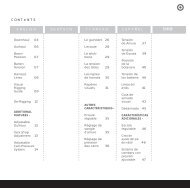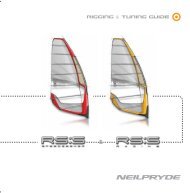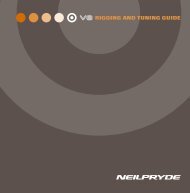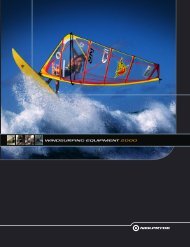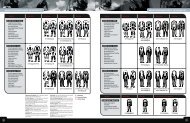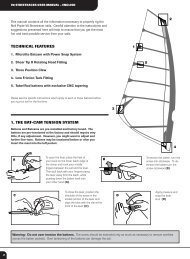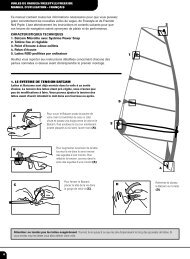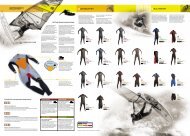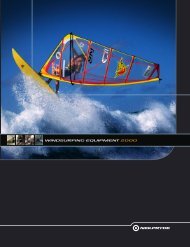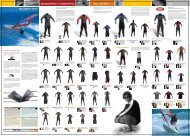You also want an ePaper? Increase the reach of your titles
YUMPU automatically turns print PDFs into web optimized ePapers that Google loves.
<strong>User</strong> <strong>Manual</strong>
NEILPRYDE V-SERIES 1998<br />
- USER MANUAL<br />
This manual contains all the information necessary to properly rig all of<br />
the <strong>Neil</strong> <strong>Pryde</strong> V-series sails. Careful attention to the instructions and<br />
suggestions presented here will help to ensure that you get the most fun<br />
and best possible service from your sails.<br />
TECHNICAL FEATURES<br />
1. Bat-Cam Batten Tension System<br />
2. Mini Head Batten<br />
3. Rotating Fixed Head System<br />
4. Rotating Adjustable Head Fitting (small & medium size sails)<br />
5. Two Position Clew<br />
6. Low Friction Tack Fitting<br />
Please see the specific instructions which apply to each of these features before you rig<br />
your sail for the first time.<br />
1. THE BAT-CAM TENSION SYSTEM<br />
Battens and Batcams are pre-installed and factory tuned. The<br />
battens are pre-tensioned at the factory and should require very<br />
little, if any adjustment. However, you might want to adjust and<br />
further fine-tune. Battens may be tensioned before or after you<br />
insert the mast into the luff pocket.<br />
A<br />
C<br />
To open the lever, place the heel of<br />
your hand on the lower leech edge of<br />
the clamp and hook your middle<br />
fingers between the sail and the lever.<br />
Then pull back with your fingers prying<br />
the lever away from the leech, while<br />
pushing down the batten itself with<br />
your other hand (A).<br />
To close the lever, position the<br />
shoulder of the screw in the<br />
socket portion of the lever and<br />
align the tube with the clip at the<br />
front of the lever (C).<br />
Warning: Do not over tension the battens. The screw should be extended only as much as necessary to remove wrinkles across the batten<br />
pockets. Over tensioning of the battens can damage the sail.<br />
B<br />
5<br />
D<br />
1<br />
2<br />
3&4<br />
Apply pressure and<br />
snap the lever shut<br />
(D).<br />
6<br />
To tension the batten, turn the<br />
screw anti-clockwise. To detension<br />
the batten turn the screw<br />
clockwise (B).
2<br />
3<br />
4<br />
A<br />
B<br />
B<br />
FIXED HEAD FITTING<br />
TWO POSITION CLEW<br />
5 6<br />
RIGGING<br />
Select the clew ring that’s best suited to your<br />
requirements. Most sailors like the boom to be<br />
roughly perpendicular to the mast, so start by setting<br />
the clew according to your preferred boom height;<br />
then adjust according to mast rake, wind conditions,<br />
and your own sailing style.<br />
THE MINI HEAD BATTEN<br />
The Mini Head Batten can be adjusted by means of the Allen key provided.<br />
The Batten is pre-tensioned at the factory and should require very little if<br />
any adjustment. Tension only until wrinkles disappear. Do not over tension.<br />
All the fixed head fittings are designed to remain attached to the sail. Never attempt to remove the fitting<br />
from the webbing at the sail head. When rigging, ensure that the finger at the bottom of the plastic fitting is<br />
seated correctly in the cup at the top of the mast. To ensure optimum rotation, please be sure to use the<br />
hard mast cup supplied.<br />
EXTENSION HEAD FITTING (SMALLER SAILS)<br />
To allow the use of a 30cm longer mast, a fixed length extension with a special mast tip plug are provided. In order<br />
to use the extension remove the gray plastic mast tip plug (A) from the webbing loop (B) that is sewn to the luff<br />
pocket (a small screwdriver is a helpful tool). Save this part (A) in case you ever want to use the recommended<br />
mast. Take the extension webbing, pry off the plastic cap, take the “U” shaped metal clip out of one of the loops,<br />
pass the extension webbing through the loop that is sewn to the luff pocket (B). Then re-hook the “U” clip, press<br />
on the plastic cap, and you are ready to rig. When you insert the mast, pass the tip between the loop (B) and the<br />
front of the pocket. Put the tip cap into the mast and tension the downhaul as necessary.<br />
A. Set your boom and mast base to the dimensions of the sail printed near the tack.<br />
The sail is designed to be perfectly trimmed on the correct mast at the<br />
recommended setting. On a smaller size sail, should you want to use a mast<br />
which is thirty centimetres longer, you may use the included head extension. Install<br />
the extension as described in number 4.<br />
B. Check that all the battens are fully inserted into their pockets.<br />
C. Tension the battens according to the instructions.<br />
D. Insert the mast into the luff pocket taking care that the cams are correctly located<br />
on the mast.<br />
E. Partially tension the downhaul using the low friction tack fitting.<br />
F. Attach the boom to the mast, allowing space above it in the cut-out so that the<br />
sail can be fully downhauled later.<br />
G. Outhaul the sail, until it is quite flat.<br />
H. Downhaul the sail to approximately 1cm above the cleat<br />
base as shown in the diagram. Fine tune around this<br />
position. A small sticker has been provided with the sail<br />
that you can wrap around your mast base and use as a<br />
reference when you find your best tuning. When in the<br />
correct tuning range the tack pulley will be as shown.<br />
I. Re-tension any battens - only as necessary - until all wrinkles across the batten<br />
pockets disappear. Be sure not to over tension the battens.<br />
J. Adjust the outhaul tension until the sail has the desired foil shape, and re-adjust<br />
the boom length so that the clew is within two centimetres of the boom end.<br />
C<br />
A<br />
D<br />
B<br />
CAM RIGGING TIPS:<br />
LOW FRICTION<br />
TACK RING<br />
The Low Friction Tack Fitting must<br />
be rigged properly to ensure<br />
maximum downhauling efficiency.<br />
Always rig the tack fitting<br />
according to the diagram.<br />
K. To ensure correct tuning for your specific sail, please consult the trim<br />
instructions that follow.<br />
Grab the cams (through the luff pocket) and work them down the mast<br />
one by one. This is easier and works better than trying to pull the luff<br />
pocket over the mast from the sail tack. Keep the two cams opposite<br />
the boom cut-out close together as you work them down the mast. The<br />
boom cut-out area of the luff pocket should be compressed and<br />
wrinkled looking during this process. This method reduces cam<br />
pressure on the mast and makes rigging a lot easier. Use the tack<br />
handle to help pull the tack fitting close to the mast base. Do not pull<br />
on the neoprene tack fairing.<br />
DE-RIGGING PROCEDURES<br />
Fold the neoprene tack fairing back over any mast base fittings before<br />
releasing the downhaul. To de-rig, just brace the mast tip against a solid<br />
object, and slide the cams up the mast one at a time, reversing the initial<br />
process.<br />
1. CAREFULLY EASE THE OUTHAUL until it is completely loose.<br />
2. NOW REMOVE THE BOOM COMPLETELY.<br />
3. THEN CAREFULLY EASE THE DOWNHAUL a little at a time.<br />
4. CAREFULLY remove the mast from the sail, taking care that the cams<br />
remain correctly positioned on the batten pocket ends.
SAIL MAINTENANCE<br />
Always store your sail rolled and dry in its sailbag. Try to prevent the sail from<br />
being crushed or badly creased. Wash the sail in fresh water after use if<br />
possible. The battens should be left in their pockets.<br />
Do not leave the sail exposed to strong or direct sunlight.<br />
Do not use any solvents or chemicals to clean it. If the sail becomes dirty, use<br />
fresh water and mild soap.<br />
TUNING NEIL PRYDE V-SERIES SAILS<br />
When correctly rigged on the beach, all of the 1998 <strong>Neil</strong> <strong>Pryde</strong> V-series sails (V8, V6) will show a<br />
little looseness in the leech. This will be most noticeable from the head to batten # 2 although the<br />
leech may be loose to batten # 3 in some sizes - especially when tuned for stronger winds. Leech<br />
looseness will not, however, generally be as pronounced as in previous years’ sails.<br />
First set the sails to the dimensions printed at the sail tack. Then, if<br />
necessary, tune the downhaul so that the leech appears just<br />
loose at the first and second batten. There may be some<br />
small wrinkles in the edge of the leech down to the first<br />
batten but these should not look pronounced or<br />
extreme. There will be looseness of the sail material<br />
inboard from the batten ends down to batten # 2 or # 3 but<br />
this will not be wrinkled looking nor will the edge of the sail be<br />
heavily wrinkled in this area. Once the upper leech looks correct (see<br />
drawings), then add outhaul until the leech makes a straight line from<br />
the first batten above the boom right up to the head. This should<br />
normally require between 2 - 4 cm of “positive” outhaul (beyond the<br />
point where you start to feel resistance). If in doubt add an additional<br />
5 - 10 mm to be sure the sail is sufficiently outhauled.<br />
A NOTE ON RIG DIMENSIONS<br />
The rig dimensions printed on the tack of all <strong>Neil</strong> <strong>Pryde</strong> collection sails<br />
show the following information:<br />
• Luff length: the distance from the sail head (along the mast) to the<br />
bottom of the tack fitting. We specify this luff length + or -1cm, +1cm<br />
indicating the hardest downhaul setting and -1cm indicating the<br />
lightest useful downhaul setting.<br />
• Boom: the distance from the forward edge of the mast (at the<br />
centre of the boom cut-out) to the sail clew. We specify this boom<br />
length at + or -1cm, +1cm indicating the flattest (hardest) outhaul<br />
setting and -1cm indicating the lightest useful outhaul setting.<br />
• Base setting: depending on whether you use a <strong>Neil</strong> <strong>Pryde</strong> Aluminum<br />
or a <strong>Neil</strong> <strong>Pryde</strong> Carbon base, we specify the ideal setting.<br />
These figures are intended as a guide to proper sail trim, and, depending<br />
on the rig components you choose, may not always correspond exactly<br />
to the settings which are best for you.<br />
SAIL SAFE, HAVE FUN<br />
Sail carefully and thoughtfully around other sailors and beach users.<br />
Before leaving the beach check all your equipment thoroughly for<br />
signs of wear or breakage. Always check the weather forecasts and<br />
take note of local conditions and potential hazards before sailing.<br />
Check for dangerous currents, and consider carefully where you<br />
might land in the event of an emergency.<br />
For further information on this or other NEILPRYDE sailing<br />
equipment contact your AUTHORISED NEILPRYDE DEALER or our<br />
distributor in your country.<br />
V6 1998<br />
V8 1998<br />
CHOOSING THE RIGHT MAST<br />
Examples of correctly tuned<br />
V-series sails.<br />
Every <strong>Neil</strong> <strong>Pryde</strong> sail is designed around a specific recommended mast.<br />
To get the optimum performance from your <strong>Neil</strong> <strong>Pryde</strong> V-series sails, use<br />
the recommended mast.* In many cases an alternative mast is specified<br />
and this will also provide good performance.<br />
* We also specify upgrade masts which will enhance the performance level<br />
of your sail.
V5<br />
Although the same guidelines as outlined for V6 and V8 apply to the V5, this sail has a few specific features:<br />
1. MINI-BATCAM BATTEN TENSION SYSTEM<br />
The battens and the Mini-Batcams are pre-installed and factory tuned. The battens are pre-tensioned at the factory and required very little, if any adjustment.<br />
However, should you want to further fine tune, you can very<br />
easily do that with the help of the attached Allen key. Note: You<br />
do NOT need to open the Mini-Batcam. Just insert the Allen key<br />
through the hole at the end of the Mini-Batcam and turn<br />
clockwise to tension and anti-clockwise to de-tension.<br />
Warning: Do not over tension the battens. You should only put<br />
enough tension to remove wrinkles across the batten pockets.<br />
Over tensioning of the battnes can damage the sail.<br />
Battens may be tensioned before or after you insert the mast<br />
into the luffpocket<br />
Should you need to open the Mini-Batcam, for example to<br />
replace a batten, please use the following procedure:<br />
■ De-tension the batten by using the Allen key and turning it<br />
anti-clockwise.<br />
■ Open the lever by placing the heel of your hand on the<br />
lower leech edge and hook your fingers between the sail<br />
and the lever. Then pull back with your fingers prying the<br />
lever while pushing down the battens with your other hand.<br />
■ To close, just apply pressure and snap the lever shut.<br />
2<br />
A<br />
F<br />
C<br />
E<br />
B<br />
F<br />
H<br />
1<br />
D<br />
G<br />
2. FRONT INSERT TENSION SYSTEM FOR<br />
FOOT BATTEN (ON SMALLER SIZES 3.9/<br />
4.4/4.9)<br />
The smaller sizes of V5 are fitted with Front Insert Tension System for the<br />
foot batten. Your sail is packaged with the foot batten removed. (A)<br />
Slide the batten into the pocket from the leech end. Open the front<br />
batcam by squeezing the arms together (F), orienting the hand as<br />
shown (D)-and insert the adjuster screw into the leech end cap (C).<br />
Then fit the tip of the batten into the socket (H). Snap shut (G), making<br />
sure the arms are fully seated and closed. If you require more tension on<br />
the batten to remove wrinkles, open the front part and adjust the length<br />
of the batten with the screw adjuster (B). Adding tension after the sail is<br />
rigged may be accomplished by placing the hands as shown (D) and<br />
applying pressure on the sail body about 30 cm back from the front<br />
batcam while using the other hand to squeeze the arms (F) to open the<br />
cam. Carefully slide the batten forward out of the leech end cap (B),<br />
adjust the screw. Then reinsert the adjuster screw, apply hand pressure<br />
(D), and snap the lever shut (G). Do Not Over Tension.



